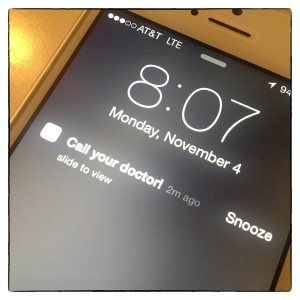
As we enter 2015, healthcare providers everywhere continue their relentless pursuit of the Holy Grail of healthcare – patient engagement. Spurred on by the Centers for Medicare and Medicaid Services (CMS), Meaningful Use and an ever-expanding health IT industry, hospitals, medical groups and physicians this year are on pace to invest even more money on Personal Health Records (PHRs), patient portals, and smart health apps all with a goal of getting patients to become “more engaged” in their own health care.
What if This is the Wrong Goal?
What if the challenge facing provider organizations was not how to “engage more” patients and members? What if the challenge for providers really should be how to be “more engaging” with the patients and members they already have?
Set aside your disbelief for a moment and consider the very real possibility that providers and payers everywhere may be going about patient engagement the WRONG WAY.
Consider the Evidence
• Doctor Visits According to the National Ambulatory Care Survey, 82% of U.S. adults (that 82% of your patients and members) visit their doctor at least once each year. On average, U.S. adults see their doctor three times a year and twice that if they have a chronic condition (which most adults over 50 years of age do). This means that provider and payer organizations are much more likely to find patients and members in their doctor’s office than in the ER, a hospital bed or on a patient portal somewhere.
 • Preparation People go to the doctor for the most part when they are concerned about something. Before deciding to see the doctor, we as patients first decide whether a doctor’s visit is necessary. We may go online and research our symptoms or discuss our concerns with family or friends. Next, we make an appointment, wait for the appointment and then arrange to take time out of our busy lives to show up for the appointment. While waiting to be seen, we make a mental list of the questions we want to ask the doctor.
• Preparation People go to the doctor for the most part when they are concerned about something. Before deciding to see the doctor, we as patients first decide whether a doctor’s visit is necessary. We may go online and research our symptoms or discuss our concerns with family or friends. Next, we make an appointment, wait for the appointment and then arrange to take time out of our busy lives to show up for the appointment. While waiting to be seen, we make a mental list of the questions we want to ask the doctor.
• Post Visit In between doctor’s visits, we watch what we eat, we wash our hands, wear our seat belts, get vaccinations, take vitamins, exercise, go online seeking health information, and so on. We try and do what we believe we need to do; what we can do, to maintain our desired level of health.
The point is that as patients we tend to invest a fair amount of cognitive effort, time and emotional energy before ever being seen by a physician, even more if we have a chronic condition. Contrary to conventional wisdom, the evidence suggests that the vast majority of patients who visit their doctors are already engaged to some extent, at least when they walk in the exam room.
How Providers Define and Measure Patient Engagement
 If there are any doubts that healthcare providers today are still very paternalistic and physician-centered, one need only consider how providers tend to define and measure patient engagement.
If there are any doubts that healthcare providers today are still very paternalistic and physician-centered, one need only consider how providers tend to define and measure patient engagement.
As the provider defines it, an engaged patient is someone who:
• Does what they are told to do, e.g., takes their medication as prescribed, “Chooses wisely,” uses the ER as directed, uses generic medications, and so on.
• Does what is in their best interest as defined by someone else, e.g., sign up and use their PHR and patient portal, review their doctor’s notes, review their online health information use wearable health-monitoring devices, and so on.
When patients fail to meet either of these provider definitions they are deemed unengaged. Physicians (and health IT professionals) don’t consider the patient’s cognitive effort and emotional energy in preparation of their doctor’s visit. Why? It doesn’t meet provider’s definition of patient engagement.
What if the Real Problem is Physicians are Not Very Engaging?
Accept for a moment that we as patients really are engaged to one degree or another (as suggested by the evidence presented above) when we visit the doctor. Now ask yourself “how engaging” it is for patients to be subjected to the following kinds of personal interactions with clinicians:
• Being interrupted by the doctor just as you start to tell your story.
• Never being asked the reason(s) for your visit.
• Never being asked if you have any questions.
• Given a 60-second primer on a new prescription, including why you need the medication, how to take the medication, indications and contraindications, when and how to stop, etc.
• Being afraid to admit you did not understand what the doctor told you.
• Not being able to share your thoughts as to your illness.
• Not being asked your thoughts as to the best treatment options.
Keep in mind that most of us as patients have been socialized since childhood to accept that the physician is in control of the visit, does most of the talking, asks most of the questions and make all the important decisions. There is nothing inherently “engaging” in the passive sick role that many physicians continue to expect patients to play today.
Before you dismiss the above as not possible in your provider or payer organization (as evidenced by your wonderful patient/member satisfaction scores) consider the following quote from an old professor of mine, Avedis Donabedian, MD, the founder of today’s quality movement in healthcare:
“Often patients are, in fact, overly patient; they put up with unnecessary discomforts and grant their doctors the benefit of every doubt, until deficiencies in care are too manifest to be overlooked. Generally speaking, one can assume that the quality of care is, actually, worse than surveys of patient satisfaction would seem to show. Patients need to be taught to be less patient, more critical, more assertive.”
Key Take-Aways
- Based upon the evidence, the challenge facing healthcare providers today is not so much one of how to engage more patients…but rather how to be more personally engaging with the patients they already have.
- As an industry, healthcare needs to shift from its’ paternalistic, physician-centric definition of patient engagement to a patient-centered definition that reflects the patient’s perspective of how they want to be engaged, including what physicians (and provider organizations) need to do to become more engaging.
- Consistent with this patient-centered approach to engagement, providers will need to redefine their roles vis à vis the patient and will need to learn how to be more engaging with patients in the way they communicate and relate to patients.
- New research methodologies beyond CAHPS and CG-CAHPS will need to be adopted to measure and track patient engagement from both the patient and physician perspective.
- Providers need to understand that patient engagement is a physician-patient communication challenge and that all the health IT in the world cannot compensate for physicians with disengaging patient communication skills.





3 Comments
Very interesting and so true! We need to put patients at the center of their care and really listen to their concerns and help them to set goals that are meaningful to them. We need to provide them with health information and encourage them to make healthy choices but we most need to be cognizant of what is most important to them. Many times in talking with patients we can help them to see what will help them the most. This is often when change occurs. I am a diabetes educator and thus have more time to interact with the patient than most physicians. However, physicians often see the same patient for many years so it is very important for physicians to spend a couple of minutes to really listen to the patient. I believe this will also lead to increased physician satisfaction, as patients who are partners in their care more often make some changes that physicians and other health care providers want them to make.
Carol,
Thanks for your comments and kind words.
While listening to patients is important for physicians, so is assessing the patient’s knowledge, understanding and agreement with their diagnosis and treatment plan. In diabetes for example, it isn’t just a question of giving patient information…information alone does not change health behavior. The clinician needs to tailor the nature and quantity of information to the patient’s existing knowledge about their condition. An experienced, controlled diabetic, for example, is much more knowledgeable and skilled than a newly diagnosed diabetic. Clinicians need to recognize this and tailor their patient teaching to these “differences”.
Thanks for an informative blog. Improving outcomes means including patients. Here’s six key factors for patient engagement: http://www.mobileprm.com/blog/wp-content/uploads/2014/12/Patient-Engagement-Key-Factors-for-Success.pdf